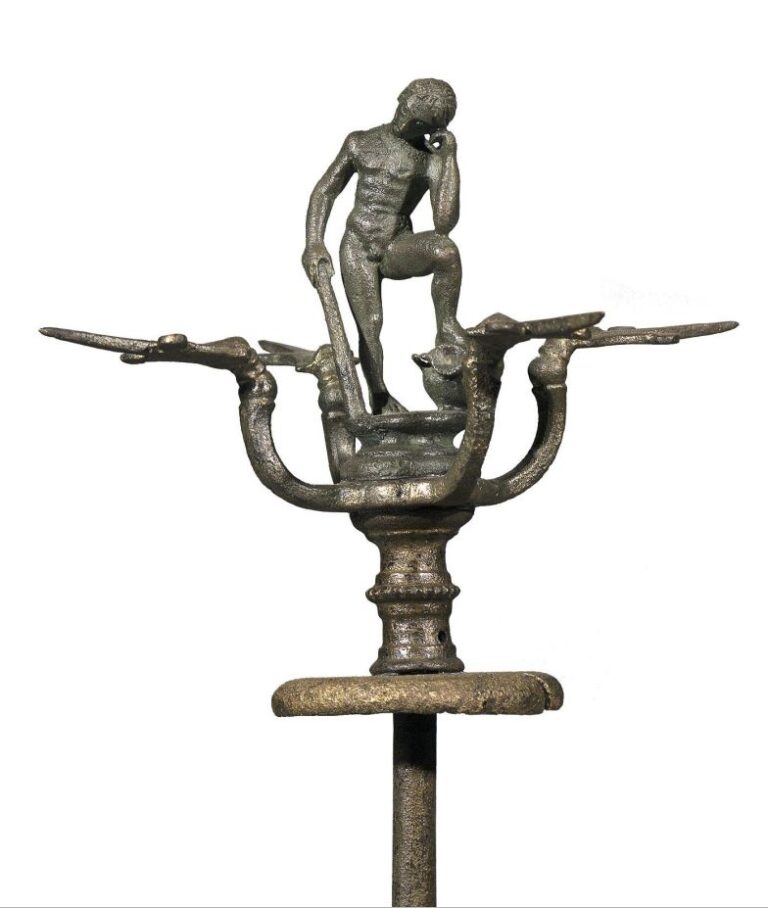Candelabrum’s figured top of probable local production presenting Heracles at rest, bronze.
Around 380-370 BC
Tomb 58C, Valle Pega
Height of the top: 10,2 cm
This figure might strike when looked at for the first time: why this unusual posture to ornate a candelabrum? This Heracles, recognizable thanks to the presence of the club, is remote from the one pictured when thinking about the Greek hero, the usual epic representations showing him drawing bows or wielding weapons. This resting posture is however part of a trend in Greek art born in the 4th century BC, which illustrates artistic and cultural transfers between Greek and Etruscan populations. We might understand it as a way to give a humanized aspect to these divine figures, here giving way to Heracles’ half-mortal part, to be better connected to the household’s space and everyday life. Calmly holding his club with one hand and holding his head up, the body is in a more intellectual pose, not being without reminding of the famous Thinker of Rodin, where the contrast between the body, the musculature, and its paradoxical uselessness orientates all thoughts on the spiritual ongoings of the character.
Another interpretation could be that Heracles is at rest to give way to nature’s power: he stands on an amphora which is meant to represent the water’s dominion, so important to the Etruscans of Spina, showing the relevance of water for them. The very city of Spina was a city of canals, directly built on water; some of the channels were navigable, and the inhabitants had to face similar problems to those that the Venetians fight today! A wooden palisade and earthen agger construction were, in a certain sense, an ancient precursor of the MOSE system that Venice recently put into place, to protect the city from the high tide. But if the ancient populations managed to govern waters, climate change and poor land management bring up new challenges to deal with for current governments, as rising sea levels increasingly threaten territories like Venice and many others.
The Po River, whose main branch bounded the city of Spina, connected the settlement to the whole Po valley. It is assumed that one of the many reasons that contributed to the gradual abandonment of the city of Spina in the 3rd century B.C. was due to the changed environmental conditions: over the centuries, the branch of the Po river, discharging its debris, progressively moved the coastline away from the city, thus distancing the port from the sea and contributing to the silting up of the area. It is possible that the sea, more difficult to reach, made Spina lose its strategic importance for trade. A similar process would happen many centuries later at Ostia, the port of Rome. The shifting of the coastline away from Spina was a natural phenomenon, but it is a strong reminder of how, despite the progress made by technology today, man is powerless in the face of certain phenomena and may benefit from going along with nature (or at least not destroy it!).
Before silting up, the river port of Spina, not far away from the sea, constituted the city’s fortune: thanks to this element, the city developed a flourishing maritime trade, particularly with Athens. Many of the objects found in the tombs of Spina and displayed in the exhibition come from Greece. Yet the sea was not only an economic means: ideas, people, and innovations traveled through this element.
The candelabrum was found inside a tomb in Valle Pega, but before its funerary function, it was used to light a house or a public space. Try to imagine that the hero represented here was meant to be surrounded by four candles placed around him, which would have changed entirely the way it was perceived. This source of light brought by fire needs to be imagined surrounded by darkness, maybe projecting intriguing staggering shadows on the surrounding walls. Heracles could have looked alive to the crowd, to a certain extent, and be of an active presence in the household.




